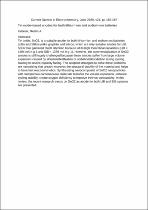JavaScript is disabled for your browser. Some features of this site may not work without it.
- ResearchSpace
- →
- Research Publications/Outputs
- →
- Journal Articles
- →
- View Item
| dc.contributor.author |
Kebede, Mesfin A

|
|
| dc.date.accessioned | 2020-06-03T13:11:08Z | |
| dc.date.available | 2020-06-03T13:11:08Z | |
| dc.date.issued | 2020-06 | |
| dc.identifier.citation | Kebede, M.A. 2020. Tin oxide–based anodes for both lithium-ion and sodium-ion batteries. Current Opinion in Electrochemistry, v21, pp 182-187 | en_US |
| dc.identifier.issn | 2451-9103 | |
| dc.identifier.uri | https://www.sciencedirect.com/science/article/pii/S2451910320300284 | |
| dc.identifier.uri | https://doi.org/10.1016/j.coelec.2020.02.003 | |
| dc.identifier.uri | http://hdl.handle.net/10204/11448 | |
| dc.description | Copyright: 2020 Elsevier. Due to copyright restrictions, only the abstract version of the work is attached. Kindly consult the publisher's website for the full text version. | en_US |
| dc.description.abstract | Tin oxide, SnO2, is a suitable anode for both lithium-ion and sodium-ion batteries (LIBs and SIBs) unlike graphite and silicon, which are only suitable anodes for LIB. SnO2 has garnered much attention because of its high theoretical capacities (LIB = 1494 mA h g-1 and SIB = 1378 mA h g-1). However, the commercialization of SnO2 anodes is still hugely challenged because these anodes suffer from large volume expansion caused by lithiation/delithiation or sodiation/desodiation during cycling, leading to severe capacity fading. The adopted strategies to solve these problems are nanosizing that greatly improves the structural stability of the material and helps to have fast reaction kinetics. Synthesizing nanocomposite of SnO2 nanoparticles with nanoporous carbonaceous materials to buffer the volume expansion, enhance cycling stability; create oxygen deficiency to improve intrinsic conductivity. In this review, the recent research trends on SnO2 as anode for both LIB and SIB systems are presented. | en_US |
| dc.language.iso | en | en_US |
| dc.publisher | Elsevier | en_US |
| dc.relation.ispartofseries | Worklist;23497 | |
| dc.subject | SnO2 anode | en_US |
| dc.subject | Lithium ion battery | en_US |
| dc.subject | Sodium ion battery | en_US |
| dc.subject | Cycling stability | en_US |
| dc.subject | Rate capability | en_US |
| dc.title | Tin oxide–based anodes for both lithium-ion and sodium-ion batteries | en_US |
| dc.type | Article | en_US |
| dc.identifier.apacitation | Kebede, M. A. (2020). Tin oxide–based anodes for both lithium-ion and sodium-ion batteries. http://hdl.handle.net/10204/11448 | en_ZA |
| dc.identifier.chicagocitation | Kebede, Mesfin A "Tin oxide–based anodes for both lithium-ion and sodium-ion batteries." (2020) http://hdl.handle.net/10204/11448 | en_ZA |
| dc.identifier.vancouvercitation | Kebede MA. Tin oxide–based anodes for both lithium-ion and sodium-ion batteries. 2020; http://hdl.handle.net/10204/11448. | en_ZA |
| dc.identifier.ris | TY - Article AU - Kebede, Mesfin A AB - Tin oxide, SnO2, is a suitable anode for both lithium-ion and sodium-ion batteries (LIBs and SIBs) unlike graphite and silicon, which are only suitable anodes for LIB. SnO2 has garnered much attention because of its high theoretical capacities (LIB = 1494 mA h g-1 and SIB = 1378 mA h g-1). However, the commercialization of SnO2 anodes is still hugely challenged because these anodes suffer from large volume expansion caused by lithiation/delithiation or sodiation/desodiation during cycling, leading to severe capacity fading. The adopted strategies to solve these problems are nanosizing that greatly improves the structural stability of the material and helps to have fast reaction kinetics. Synthesizing nanocomposite of SnO2 nanoparticles with nanoporous carbonaceous materials to buffer the volume expansion, enhance cycling stability; create oxygen deficiency to improve intrinsic conductivity. In this review, the recent research trends on SnO2 as anode for both LIB and SIB systems are presented. DA - 2020-06 DB - ResearchSpace DP - CSIR KW - SnO2 anode KW - Lithium ion battery KW - Sodium ion battery KW - Cycling stability KW - Rate capability LK - https://researchspace.csir.co.za PY - 2020 SM - 2451-9103 T1 - Tin oxide–based anodes for both lithium-ion and sodium-ion batteries TI - Tin oxide–based anodes for both lithium-ion and sodium-ion batteries UR - http://hdl.handle.net/10204/11448 ER - | en_ZA |






